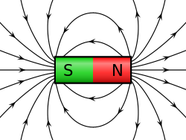..................................................................................................
Magnetism is a fundamental property of nature.
Because there is no "Unified Theory of Physics", our
knowledge of magnetism, like everything else, is incomplete.
Angular momenta of electrons (and to a lesser extent, nuclei) impart
some magnetic characteristics to all materials.
Magnetism extends as a field far beyond the atomic
level, however, and is intimately connected with electrical phenomena.
Any current, moving charge, or changing electrical potential also
generates a magnetic field.
To the ancients, magnetism was a recognized but mysterious force.
Greeks living in Magnesia occasionally found rare and wonderful
brownish-black rocks that had the power to attract objects made of iron.
Known as lodestones, these were chunks
of iron oxide (magnetite) that had probably been struck by lightning.
Similar stones were discovered in Asia and by the 12th Century the
Chinese used them to make compasses for navigation.
Today even small children are familiar with the attraction and
repulsion of hand-held permanent magnets, the modern successors to lodestones.
Today we understand that the static magnetic fields associated with
lodestones and permanent magnets derive principally from the total angular
momentum of electrons within those materials.
Lone electrons possess spin, a quantized
fundamental property of nature denoted by the letter S.
In addition to S, electrons orbiting a nucleus also
possess orbital angular momentum (L).
Together S + L = J, or total angular
momentum, is the property primarily responsible for bulk magnetism.
Nuclei and other subatomic particles also possess spin angular
momentum, but this effect is too weak to affect gross magnetic properties of a
material.
The relationship between electricity and magnetism was not appreciated
until 1819 when Danish physicist Hans Christian Oersted accidentally noticed the deflection of a compass on a nearby table
while performing experiments with electrical currents in his laboratory.
In 1826 André-Marie Ampère formally demonstrated the relationship between current and
strength of the resultant magnetic field (B), whose direction is found by the right-hand
rule.
Not only do electrical currents produce magnetic fields, but changing
magnetic fields induce electrical currents.
In 1831 Michael Faraday demonstrated the principle of
magnetic induction by measuring the voltage (V) produced in
a coil by a moving magnet.
Three years later Heinrich Lenz showed that the current induced
was so directed as to oppose the change in magnetic flux.
The resultant Faraday-Lenz Law can be written
V ∝ −(dB/dt)
where dB/dt represents the rate change of the
magnetic field.
The negative sign reflects Lenz's principle that the induced current
creates a "counter field" in a direction opposite to B.
In the last half of the 19th Century a number of European physicists
worked out further details of electromagnetic phenomena.
Their names are legendary -- Carl Friedrich Gauss, Hendrik
Antoon Lorentz, Joseph Henry, Heinrich Hertz, among others.
James Clerk Maxwell made perhaps the most important
contribution unifying magnetism, electricity, and light under a common
wave-based electromagnetic theory.
In the 20th Century Albert Einstein successfully recast the Maxwell
equations into a relativistic framework.
Paul Dirac, Enrico Fermi, Richard Feynman and others subsequently
integrated magnetism into quantum mechanics creating the new field of Quantum
Electrodynamics (QED).
In the 21st Century the boundaries of theory are being expanded to
explain magnetic behavior on both very large (galaxy-size) and very small
(sub-sub-atomic) levels.
Still, no single model exists that explains all electromagnetic
phenomena.








No comments:
Post a Comment